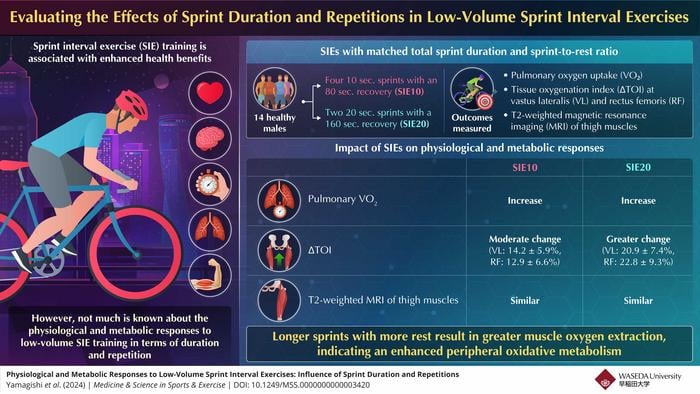Researchers from Japan have shed light on the optimal structure of sprint interval training (SIT) protocols to maximize physiological responses and overall well-being. The team, led by Dr. Takaki Yamagishi from the Japan Institute of Sports Sciences and Professor Yasuo Kawakami from Waseda University, conducted experiments with healthy human volunteers to compare the effects of two different sprint interval exercises (SIE) on oxidative metabolism and muscle activation.
Unraveling the Ideal Sprint-to-Rest Ratio
The researchers matched two SIE protocols, SIE20 and SIE10, for total sprint duration and sprint-to-rest ratio. SIE20 consisted of two 20-second sprints with 160-second recovery, while SIE10 involved four 10-second sprints with 80-second recovery. By analyzing pulmonary oxygen uptake (V̇O2) levels, changes in tissue oxygenation index (∆TOI) in thigh muscles, and T2-weighted magnetic resonance imaging (MRI) data, the team discovered that SIE20 outperformed SIE10 in terms of peripheral oxidative metabolism.
“Establishing a minimum dose of exercise training to bring about training benefits, such as aerobic fitness, has been one of my main research interests. Due to the support from Prof. Kawakami and other co-authors, along with the collaboration with Waseda University, this unique research work using a multifaceted approach was possible,” explained Dr. Yamagishi, highlighting the motivation behind the study.
Addressing Time Constraints in Physical Activity
The findings of this study have significant real-life applications, particularly in addressing the lack of time as a major hindrance to regular physical activity. “In today’s fast-moving world, lack of time is a major hindrance to regular physical activity. However, the exercise modalities employed in our study require less than 15 minutes to complete and provide considerable health benefits,” emphasized Dr. Yamagishi.
The research fills important gaps in SIT studies, such as the effects of minimum sprint duration and repetitions on aerobic and metabolic responses in humans. The insights gained from this study can contribute to the improvement of training programs and exercise regimens, with the potential to be included in future exercise guidelines proposed by major organizations like the American College of Sports Medicine.
Keyword phrase: optimal sprint interval training protocol


